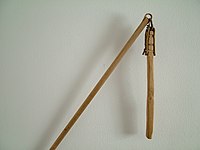This article needs additional citations for verification. (November 2023) |
A flail is an agricultural tool used for threshing, the process of separating grains from their husks.
It is usually made from two or more large sticks attached by a short chain; one stick is held and swung, causing the other (the swipple) to strike a pile of grain, loosening the husks. The precise dimensions and shape of flails were determined by generations of farmers to suit the particular grain they were harvesting. For example, flails used by farmers in Quebec to process wheat were generally made from two pieces of wood, the handle being about 1.5 m (4.9 ft) long by 3 cm (1.2 in) in diameter, and the second stick being about 1 m (3.3 ft) long by about 3 cm (1.2 in) in diameter, with a slight taper towards the end. Flails for other grains, such as rice or spelt, would have had different dimensions.
Flails have generally fallen into disuse in many nations because of the availability of technologies such as combine harvesters that require much less manual labour. But in many places, such as Minnesota,[1] wild rice can only be harvested legally using manual means, specifically through the use of a canoe and a flail that is made of smooth, round wood no more than 30 inches long.
-
An example of a grain flail
-
Flail being used for threshing
-
Flails used in Britain
-
French peasants threshing with flails c. 1270.
-
Two flails pictured in the coat of arms of Teuva
- ^ "Wild Rice Regulations". Minnesota Department of Natural Resources. Retrieved 6 September 2013.




